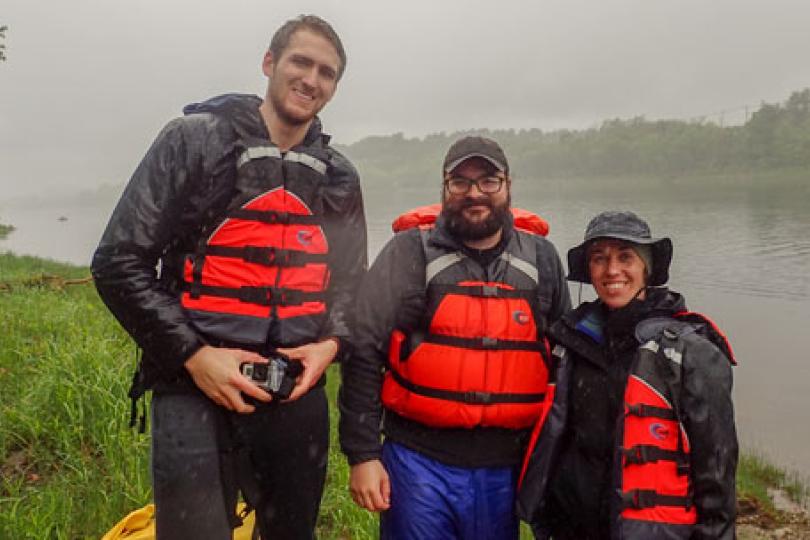Bridie McGreavy: Examining media’s coverage of dam decision-making in Maine
Editor's note: The following article first appeared on The University of Maine's website.
UMaine researchers Bridie McGreavy and Darren Ranco; students Tyler Quiring, Brawley Benson, and Nolan Altvater; and partners in the Natural Resources Department in the Penobscot Nation including Jan Paul, Angie Reed and John Banks are investigating an issue that impacts us all: how news media coverage can shape the public understanding about important science issues.
In particular, their research asks questions about how news articles represented the Penobscot River Restoration Project and the role of Penobscot Nation in the dam removal decision-making process.
News coverage matters for decision-making about dams
McGreavy, an assistant professor of environmental communication, is a UMaine co-Principal Investigator on the Future of Dams Project which is an NSF-EPSCoR Project managed by the Mitchell Center for Sustainability Solutions in collaboration with the University of New Hampshire and partner institutions. The project works to link science with decision making about dams in New England. Her team is studying news media coverage of the Penobscot River Restoration Project. The idea for the project came from partners in the Penobscot Nation who wanted to learn about how their leadership of this effort was covered by the press.
So, together, they decided to examine news articles to find out.
This focus is important because the Penobscot Nation has decades of water quality data and is a leader in water quality monitoring in Maine. Jan Paul and Angie Reed, collaborators in the Water Resources Program in the Penobscot Nation, have helped the UMaine team learn about the extensive water monitoring efforts that extend into the far reaches of the Penobscot River.
Reed says “It’s always an honor to share the work we do to bear witness to the health of the Penobscot River and the many tools we use to protect and restore it. Western science is yet another conversation Penobscot people will have in their thousands-of-years old relationship with and reciprocal responsibility to their river. It opens a dialogue with non-Native people about the willingness to be present for the long-term and continue working regardless of the level of attention received.”
Despite the extensive monitoring efforts and the Penobscot Nation’s role in the restoration-related science, when the team analyzed over 300 news articles concerning the Penobscot River Restoration Project, they found although the Penobscot Nation was identified as a key leader in the project, the cultural value and spiritual connection was emphasized while their extensive scientific work was not part of the news story.
McGreavy and her team are using these data to understand how news media may be shaping the broader awareness of Penobscot Nation’s role in the river restoration, as well as its ongoing stewardship and scientific research. “The science that Penobscot Nation practices is infused with cultural knowledge” said McGreavy. “It’s science that comes from an ethic of stewardship and care – it’s an enriched approach to science.”
They have also started working with Nolan Altvater, an undergraduate student in the Wabanaki Youth in Science program (WaYS) to document and help change the media narratives about the Penobscot Nation’s cultural approach to science and environmental monitoring.
“The WaYS program has given me the opportunity to explore and facilitate my interests in photography and writing while learning more about Wabanaki environmental leadership, which is something very important to my culture” said Altvater. “I’ve created a media archive and taken photographs, important work in which I can share with others.”
Penobscot dam research could have global impact
This team hopes their media research project, funded by a Research Reinvestment Fund (RRF) project entitled “Interdisciplinary research for decision-making about dams in Maine,” will result in an increased awareness of the work the Penobscot Nation does to protect and restore the Penobscot River, through both its deep cultural attachment and extensive science.
Removing dams and building bridges
Through the RRF’s Undergraduate Assistantship Award, McGreavy, Ranco, Quiring, Benson and Altvater have been responding to themes from the media analysis by directly documenting the work of the Nation’s water resources program.
“This study has helped us identify new opportunities for media that can tell parts of the story that aren’t typically told,” says Quiring. “Through our collaborative project, we are building a media library for the tribe to use in their community engagement and outreach efforts.”
The team will also be producing academic research that will speak to a broader, more global audience through their collaboration with agencies in a blend of science and cultural knowledge.
Darren Ranco, Associate Professor of Anthropology and Chair of Native American Programs, notes, “This research collaboration is a good example of the mutually beneficial relationship that the Penobscot Nation and the University of Maine have been developing in recent years, as is reflected in the May, 2018 Memorandum of Understanding between the University and the Nation on the protection of Penobscot cultural heritage items.”
In addition to these important institutional research commitments, McGreavy believes students also benefit greatly from interdisciplinary learning and leadership roles as they perform research that connects with community needs directly.
“It’s been very rewarding,” said McGreavy. “We’re learning how to build collaborative partnerships and to make it easier to cross those bridges – literal bridges that separate us."

